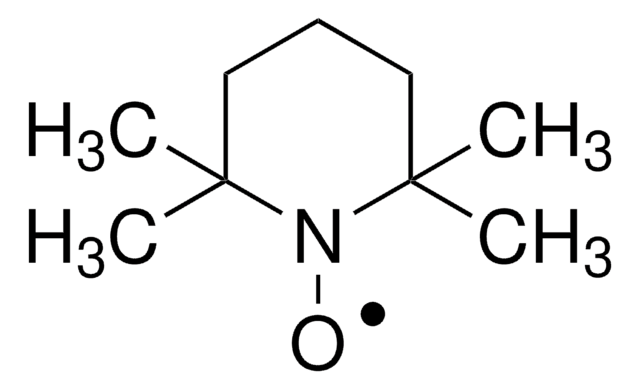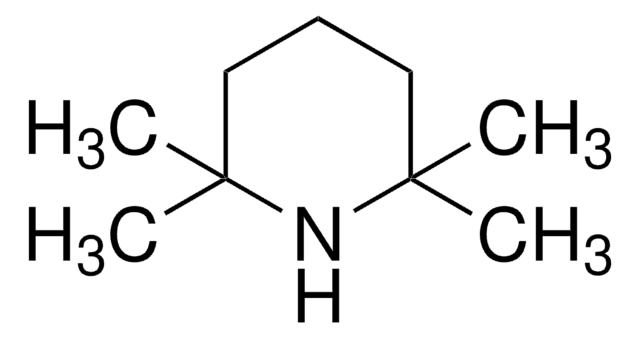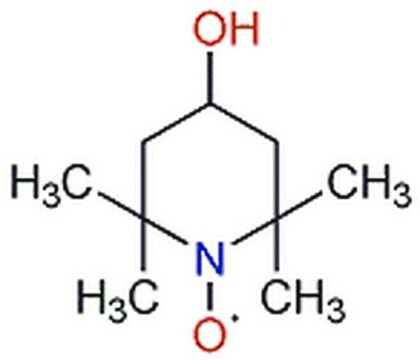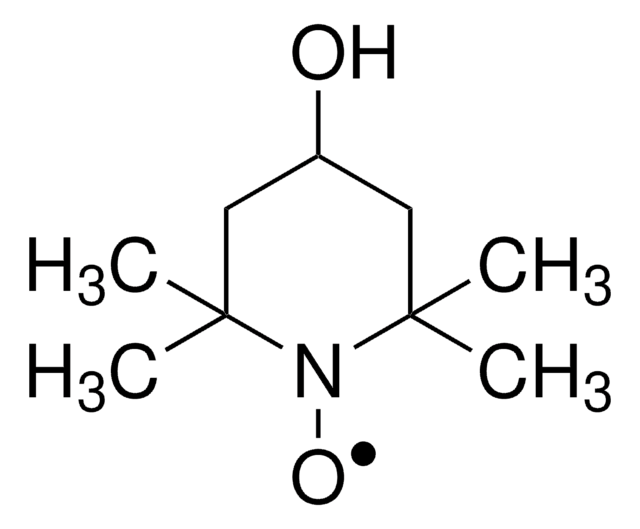92688
5,5-Dimethyl-1-pyrroline N-oxide
for ESR-spectroscopy
Sinônimo(s):
DMPO
Faça loginpara ver os preços organizacionais e de contrato
About This Item
Fórmula empírica (Notação de Hill):
C6H11NO
Número CAS:
Peso molecular:
113.16
Beilstein:
107603
Número CE:
Número MDL:
Código UNSPSC:
12000000
ID de substância PubChem:
NACRES:
NA.21
Produtos recomendados
grau
for ESR-spectroscopy
Nível de qualidade
Ensaio
≥98.0% (GC)
forma
crystals
índice de refração
n20/D 1.496 (lit.)
pb
75 °C/0.4 mmHg (lit.)
pf
25-29 °C (lit.)
densidade
1.015 g/mL at 25 °C (lit.)
temperatura de armazenamento
−20°C
cadeia de caracteres SMILES
CC1(C)CCC=[N+]1[O-]
InChI
1S/C6H11NO/c1-6(2)4-3-5-7(6)8/h5H,3-4H2,1-2H3
chave InChI
VCUVETGKTILCLC-UHFFFAOYSA-N
Procurando produtos similares? Visita Guia de comparação de produtos
Categorias relacionadas
Aplicação
5,5-Dimethyl-1-pyrroline N-oxide is a reagent generally used either as a free-radical spin-trapping agent, or electrophilic component during the synthesis of pyrrolidine derivatives. It may also be considered as 1,3-dipole in cycloaddition processes.
Neuroprotective agent; nitric oxide spin trap. Used to study radicals formed by enzymatic acetaldehyde oxidation. Incubation of lymphocytes with DMPO decreased DNA damage by NiCl2.
Embalagem
Bottomless glass bottle. Contents are inside inserted fused cone.
Código de classe de armazenamento
11 - Combustible Solids
Classe de risco de água (WGK)
WGK 3
Ponto de fulgor (°F)
203.0 °F - closed cup
Ponto de fulgor (°C)
95 °C - closed cup
Escolha uma das versões mais recentes:
Já possui este produto?
Encontre a documentação dos produtos que você adquiriu recentemente na biblioteca de documentos.
Karim Michail et al.
Analytical chemistry, 84(15), 6739-6746 (2012-06-26)
Free radicals are conventionally detected by electron paramagnetic resonance (EPR) spectroscopy after being trapped as spin adducts. Albeit this technique has demonstrated utmost efficacy in studying free radicals, its application to biological settings is intrinsically hampered by the inevitable bioreduction
Murugesan Velayutham et al.
Free radical biology & medicine, 51(1), 160-170 (2011-05-07)
In cells, mitochondria, endoplasmic reticulum, and peroxisomes are the major sources of reactive oxygen species (ROS) under physiological and pathophysiological conditions. Cytochrome c (cyt c) is known to participate in mitochondrial electron transport and has antioxidant and peroxidase activities. Under
Pedro L Zamora et al.
The journal of physical chemistry. A, 116(26), 7210-7218 (2012-06-07)
Radical forms of sulfur dioxide (SO(2)), sulfite (SO(3)(2-)), sulfate (SO(4)(2-)), and their conjugate acids are known to be generated in vivo through various chemical and biochemical pathways. Oxides of sulfur are environmentally pervasive compounds and are associated with a number
Emiko Sato et al.
Journal of biochemistry, 150(2), 173-181 (2011-05-17)
The nicotinamide adenine dinucleotide (NADH)/nicotinamide adenine dinucleotide phosphate (NADPH) oxidase and the xanthine oxidase (XOD) systems generate reactive oxygen species (ROS). In the present study, to characterize the difference between the two systems, the kinetics of ROS generated by both
Suchandra Bhattacharjee et al.
Nucleic acids research, 40(12), 5477-5486 (2012-03-06)
Oxidative stress-related damage to the DNA macromolecule produces lesions that are implicated in various diseases. To understand damage to DNA, it is important to study the free radical reactions causing the damage. Measurement of DNA damage has been a matter
Nossa equipe de cientistas tem experiência em todas as áreas de pesquisa, incluindo Life Sciences, ciência de materiais, síntese química, cromatografia, química analítica e muitas outras.
Entre em contato com a assistência técnica






